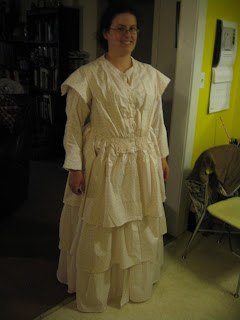It really kills me and I hope I can be the change I hope to see.
Yes, I'm guilty of it, a lot lately. I wear tennis shoes with my 1850s work attire so that I can get through the shift without having my feet amputated. I'm eventually planning to get a pair of nice reproduction shoes that are more appropriate. I even roll up my sleeves when I'm working and expose my bare arms (gasp!). Small sacrifice to be made for the sake of doing one's job, however there are exceptions to every rule.
I discovered the source of the problems I have with the women's dresses in Columbia State Park. They're all based off one example (of which there seems to be some discrepancy as to the age of the garment itself). Something like this does not help to create a glimpse of how Gold Rush Columbia looked, it creates a town where every woman wears the exact same dress, but in different colors and with the same fitting problems.
The dress pattern is printed by a company called
Chile n Cracker's. It's not necessarily a bad pattern, it's simple, but for what it's supposed to be it does the job. The pattern is based on a late 1850s work dress in the private collection of the company's owner. It appears that the owner attempted to pull a Janet Arnold and make a pattern based off of the existing garment (which is great!).
However, this is not the problem I have with the dresses. The problem I have is with the woman who makes them. From what people tell me she's very "into" what she does and supposedly understands sewing and women's clothing from the 19th century. I don't agree with this completely. If she really did understand what she was doing, she wouldn't use the same unflattering work dress pattern for every dress she's ever made. It's a bit like looking at a Ren Faire when you wander through the shops; every woman has the same frumpy calico dress that's too short with a bodice that doesn't fit. What wasn't taken into account when the park decided to make everyone dress up was the pattern for this dress. Would a woman really want to be seen in a dress that looked like that? Would she want customers of her shop to see her dressed like that? I don't think so. That's where the bad history comes in.
What is not known about the dress that the whole mess is based off of, is who owned it. What did that woman do for a living? Was this the equivalent of her house dress or lounge pants? Sure we all have frumpy clothes in our closet that we wear for comfort when we're home, but very rarely do we want people to see them. If the pattern was created accurately from this dress and reflects the geometry of the original bodice, it seems that these work dresses all fit into this category.
As a friend of mine said when she saw me sewing on my new dress, I hope this will inspire people to dress better when they see the finished result.















